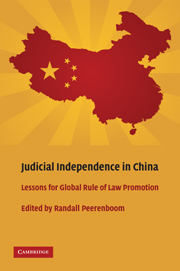Book contents
- Frontmatter
- Contents
- Contributors
- 1 Introduction
- 2 Halfway Home and a Long Way to Go
- 3 A New Approach for Promoting Judicial Independence
- 4 The Party and the Courts
- 5 Judicial Independence in China
- 6 A New Analytic Framework for Understanding and Promoting Judicial Independence in China
- 7 Judicial Independence and the Company Law in the Shanghai Courts
- 8 Local Courts in Western China
- 9 The Judiciary Pushes Back
- 10 Corruption in China's Courts
- 11 A Survey of Commercial Litigation in Shanghai Courts
- 12 Judicial Independence in Authoritarian Regimes
- 13 Judicial Independence in East Asia
- Index
- References
3 - A New Approach for Promoting Judicial Independence
Published online by Cambridge University Press: 05 June 2012
- Frontmatter
- Contents
- Contributors
- 1 Introduction
- 2 Halfway Home and a Long Way to Go
- 3 A New Approach for Promoting Judicial Independence
- 4 The Party and the Courts
- 5 Judicial Independence in China
- 6 A New Analytic Framework for Understanding and Promoting Judicial Independence in China
- 7 Judicial Independence and the Company Law in the Shanghai Courts
- 8 Local Courts in Western China
- 9 The Judiciary Pushes Back
- 10 Corruption in China's Courts
- 11 A Survey of Commercial Litigation in Shanghai Courts
- 12 Judicial Independence in Authoritarian Regimes
- 13 Judicial Independence in East Asia
- Index
- References
Summary
Suggesting a new approach for promoting judicial independence is an ambitious but necessary project. This chapter begins with a critique of the current dominant approach based on global best practices and then considers alternatives. Examples are used throughout to illustrate both criticisms of the best-practices approach and the potential benefits of alternative approaches. These alternatives emphasize the need to pay more attention to context, to culture and politics, to bad local processes, and to actual results of particular reforms. Real-life examples are essential because so-called international best-practice standards are often too abstract and too far removed from reality in many countries to be effectively implemented. Although international best practices may serve a useful heuristic purpose for legal reformers in some circumstances, they can easily become intolerant one-size-fits-all dogmas that hinder progress.
WHAT IS WRONG WITH GLOBAL STANDARDS? THE DENIAL OF CULTURE AND POLITICS
In Global best practises: a model state of the judiciary report, a strategic tool for promoting, monitoring and reporting on judicial integrity reforms, IFES (International Foundation for Electoral Systems), one of the most experienced and influential actors in the rule of law promotion business, states:
One of the best ways to promote the implementation of key, priority judicial reforms, particularly those that relate to transparency and accountability in the judiciary, is to democratize the judiciary by providing the public with quality information on the state of the judiciary through annual, systematic, prioritized monitoring and reporting tools.…The Judicial Integrity Principles represent high priority consensus principles and emerging best practises found in virtually all global and regional governmental and non-governmental instruments and key international case law related to the independence and impartiality of the judiciary.
- Type
- Chapter
- Information
- Judicial Independence in ChinaLessons for Global Rule of Law Promotion, pp. 37 - 51Publisher: Cambridge University PressPrint publication year: 2009
References
- 1
- Cited by

